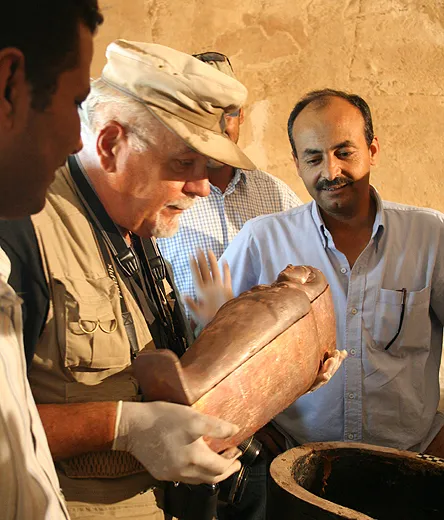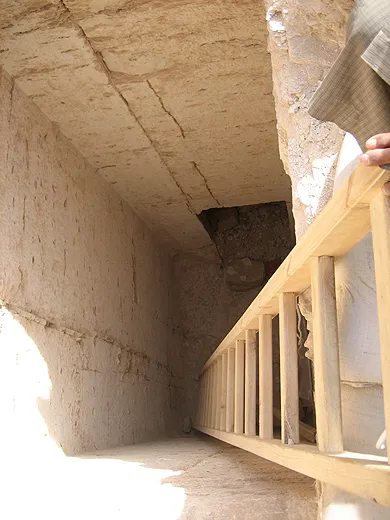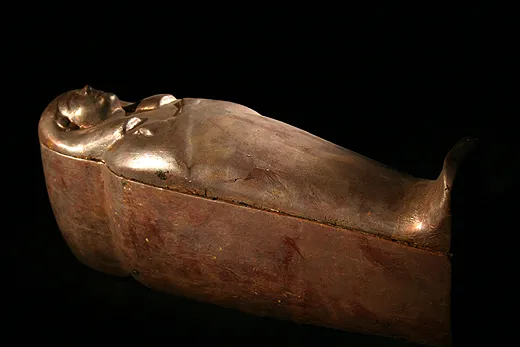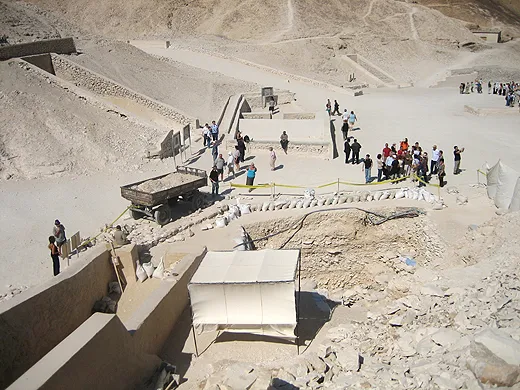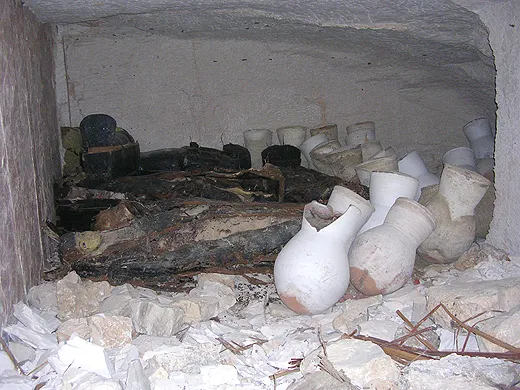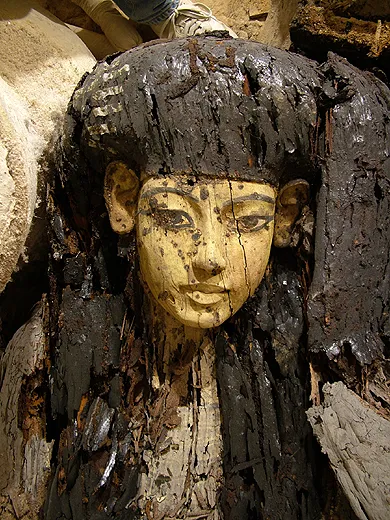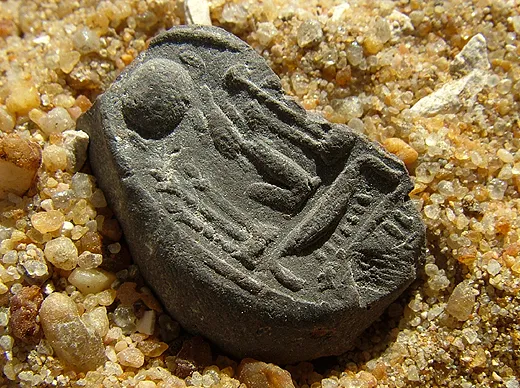A Mystery Fit For A Pharaoh
The first tomb to be discovered in the Valley of the Kings since King Tut’s is raising questions for archaeologists about ancient Egypt’s burial practices
It is barely 7:30 a.m. in the Valley of the Kings, and tourists are already milling just beyond the yellow police tape like passersby at a traffic accident. I step over the tape and show my pass to a guard, who motions for me to climb down a wooden ladder sticking out of a small, nearly square hole in the ground. Eighteen feet down a vertical shaft, the blazing Egyptian sun is gone, the crowd's hum is muted and the air is cool. In a small chamber lit by fluorescent lamps, a half-dozen archaeologists are measuring, drawing and gently probing relics in the first tomb to be found in the Valley of the Kings, more than 400 miles up the Nile from Cairo, since the resting place of King Tutankhamen was discovered here 84 years ago.
A jumble of seven wooden coffins of various sizes fills one corner of the room. Termites have turned parts of some of them into powder, while others have suffered only a thin layer of dust. Edwin Brock, an Egyptologist formerly at the American University of Cairo, is on his knees, cataloging the contents of a coffin filled with a strange assortment of pottery, rocks, cloth and natron—the powdery substance used to dry mummies. A couple of yards away, University of Chicago archaeological artist Susan Osgood intently sketches the serene yellow face painted on a partially intact coffin. It was likely built for a woman; men's faces were typically rendered a sunburned red. Deeper in the pile, a child-size casket is nestled between two full-sized ones. Something resembling a pillow seems to bulge out of another casket. The 17-foot-long space, which has plain limestone walls, also holds a number of knee-high ceramic storage jars, most still sealed.
Nervous about bumping into someone—or worse, something—I make my way back out to the narrow shaft and climb to the surface with Otto Schaden, the dig's director. Until this past February, he had worked in obscurity, splitting his time between studying a minor Pharaoh's tomb nearby and playing bass fluegelhorn in a Chicago band. Back up amid the heat and tourists, the 68-year-old archaeologist pulls out tobacco and bread crumbs, thrusting the first into a pipe and flinging the second onto the ground for some twittering finches. Just yards away, visitors in shorts and hats are lining up to get into King Tut's cramped tomb, named KV-62 because it was the 62nd tomb found in the Valley of the Kings.
Accordingly, Schaden's newly opened chamber is KV-63. Unlike Tut's, it contains neither gold statues and funerary furniture nor, as of early June, the mummified body of a long-dead Pharaoh. Despite the coffins, this probably isn't even a gravesite. Still, the discovery, announced in February, was trumpeted worldwide, because most archaeologists had long ago given up hope of finding significant discoveries in the valley. More remarkably, the artifacts appear to have been undisturbed for more than three millennia, not since one of Egypt's most fascinating periods—just after the death of the heretic king Akhenaten, who, unlike his predecessors, worshiped a single deity, the sun god Aten.
The child-size coffin in KV-63 held the flashiest artifact: a second, nested coffin coated in gold leaf. It was empty. Instead of the usual mummies, the other coffins opened so far contain only a bizarre assortment of what appears to be debris and constitute a 3,000-year-old mystery: Why fill coffins and jars with rocks and broken pottery, then carefully seal them up? Why hew out a subterranean chamber only to turn it into a storeroom? And who went to all this effort? "It may not be the most glamorous find," says Betsy Bryan, an Egyptologist at Johns Hopkins University, "but it is a whole new kind of entombment—which raises all kinds of questions."
For 400 years beginning around 1500 b.c., the rulers of three powerful Egyptian dynasties built their tombs here in the Valley of the Kings, what they called "The Great and Majestic Necropolis." During the peak of ancient Egypt's wealth and influence, artists and masons carved and decorated miles of underground corridors for the afterlife of some five dozen kings, along with their wives, children and principal ministers. Egyptians filled the tombs with untold wealth, a grandeur only hinted at by the relatively modest grave of Tutankhamen, who died at around age 19 and whose tomb is small and unadorned compared with those of other Pharaohs.
The burials halted abruptly around 1100 b.c.—following the chaotic reign of Ramses XI. After his death, the long-unified Egyptian state broke apart. The valley, once constantly policed, was looted repeatedly over nearly three millennia. No known tomb survived completely unscathed. Even Tut's was rifled more than once before the volatile British archaeologist Howard Carter entered it in 1922, climaxing an obsessive, two-decade search for the young monarch's resting place.
Unlike Carter, Otto Schaden had not been on a search for some spectacular discovery. Starting in the early 1990s, he had labored quietly, exploring the tomb built for a Pharaoh named Amenmesse, who reigned briefly around 1200 b.c. Like most of the others, Amenmesse's tomb had been looted over the centuries, and flash floods eventually filled its passages with debris; it was one of the first in the valley to be explored, in the early 1800s, by European travelers. When Schaden began working on it in 1992, "you had to crawl in on your stomach," recalls Lorelei Corcoran, who directs the Egyptian institute at the University of Memphis in Tennessee, the project's institutional sponsor.
Once most of the tomb was cleaned out, Schaden turned his attention to the area surrounding it. In 2001, he excavated a collection of workmen's huts dating roughly to Amenmesse's time. For three seasons, his team sifted through broken pottery, flint tools and the remains of date palm fruits enjoyed by workers in the makeshift village. But Schaden and his colleagues were not the first to explore the huts. Among the artifacts, they found an empty bottle of Chablis and a New York Times dated February 5, 1907, no doubt left by wealthy American archaeologist Theodore Davis who had worked with Carter. Davis had looked under the floors of the easternmost huts for Tut's tomb, but finding only bedrock, he had given up.
But one small area close to the entrance of Amenmesse's tomb had escaped their attention. "People don't normally look a few yards from one tomb to find another," Schaden explains. "You never know what might be tucked away here," he says, gesturing around the narrow, craggy valley.
One morning in March 2005, a workman probing beneath the floor of one of the huts discovered chips of rock instead of bedrock. Schaden was summoned. Trying to contain his excitement, he began taking photographs, while the excavators watched him, puzzled. "They thought I was crazy because there are white rock chips here everywhere," he says. But the archaeologist had a hunch that these rock chips filled a shaft—maybe even a tomb. By the next day, the workmen had indeed found the entrance to a shaft, roughly six feet by five feet. But it wasn't perfectly rectangular; one corner was jagged. Schaden quickly grasped the significance: two other 18th-dynasty valley tombs have similar corners, likely intended to fool robbers looking for a smoothly carved tomb entrance.
Schaden immediately halted work on the shaft to inform Egyptian antiquities officials of the discovery. He was reluctant to proceed any further because the digging season was nearly at an end, money was running low and his team was tired. The officials gave him approval to refill the shaft. Waiting from March until the next season began in December to find out where the shaft led may seem like a perverse form of self-denial, but Schaden also needed time to prepare for what he knew was coming. Had he rushed through the dig and found the underground chamber, he says, "things could have gotten out of hand. I didn't want to risk anything getting blown out of proportion."
Otto Schaden is clearly not a man who likes things to get out of hand. He seems, in fact, to model himself more on 19th-century gentlemen explorers than 21st-century scientists. A scrapbook he keeps shows him wearing a pith helmet and a tan outfit, looking like a 19th-century British explorer. "I'm basically a Victorian with a mobile phone," he likes to say.
As a child, Schaden had been fascinated by the mummies in Chicago's Field Museum. He studied Egyptology at the University of Chicago's Oriental Institute and made his first trek to Egypt as a student in the 1960s, stopping in Vienna to buy a fluegelhorn, which he played on the boat to Alexandria. In the 1960s and '70s, he worked at sites from Sudan to Giza, but he never landed a full-time academic position in the small and competitive world of Egyptologists. For the past decade, the University of Memphis provided administrative support and an occasional student to help him dig, but no money. He has raised his own funds from private donors and relies heavily on volunteers who often pay their own way. He gets by on Social Security and earnings from gigs with his Bohemian music band. His tastes are simple. Says his longtime colleague and friend Earl Ertman, a University of Akron art historian: "Otto likes bread and beer."
On Christmas Day 2005, Schaden and his team were back in the valley clearing away the fill they had piled over the shaft nine months before. As they dug down, they could tell from layers of sediment that the shaft had been cut and filled sometime before the construction of the workers' huts. By February 5, the ancient shaft was almost clear; stones and rubble still blocked the entrance to a chamber, but there was a small opening at the top, "so tiny you could barely get a flashlight in," Schaden recalls. Peeking through the opening, Heather Alexander, a team photographer, thought she spotted a coffin. Alistair Dickey, an Irish archaeologist, also took a look. "I see pots!" he shouted. "I see pots!"
The February 10, 2006, announcement by Zahi Hawass, chief of Egypt's Supreme Council on Antiquities, of the find made headlines around the world, shattering Schaden's calm. Within days, he had enlarged the hole, revealing coffins and many jars—though none of the boxes or chests typical of unplundered royal tombs, nor royal insignias. Unlike Tut's tomb nearby, this one held no gold mask, no gilded furniture, no delicate statues.
On February 13, Schaden picked his way across a rubble-littered chamber floor to get his first close-up look at the coffins. Four had been badly eaten by termites, but three appeared to be in good condition. All were covered in black resin ; on four of them, yellow faces had been painted and one featured glass-inlaid eyes and eyebrows.
After clearing the rubble away and collecting all loose artifacts, the crew jury-rigged a pulley system to hoist the 28 massive jars, each of which weighed 100 to 150 pounds, 18 feet to the surface. The first dozen jars to be opened contained a mix of pottery, mud seals, wood, cloth and natron. ("Very strange," says Schaden.)
Over several months, Egyptian conservators consolidated the artifacts and removed some of the seven coffins from the tomb. Researchers used small spoons to remove the natron. Pottery fragments and rock were wrapped in cloth for future study. Some of the coffins looked nearly new. Because the team has to excavate and document the coffins one at a time, one remains sealed. "The wood of that one is in good shape," Schaden says. "I even knocked on it when I could get close enough."
Some clues link the cache to Tut's time. One jar held wine residue similar to that found in the boy-king's tomb. "Either the material is from his burial, or it is from someone buried soon before or soon after or during his reign," Schaden says. And some of it looks remarkably similar to about 20 jars found by Davis in 1906 in pit KV-54; they held pottery, cloth, natron and other materials believed to have been used to embalm Tutankhamen. "If I didn't know that KV-63 had been sealed since the 19th dynasty," says Schaden, "I'd have sworn that Davis dumped some of the material from the pit here."
What seems clear is that someone in the New Dynasty gathered up the items in KV-63 quickly. Perhaps even in haste: shards from a single pot are distributed haphazardly in various coffins or jars. "All the stuff had to be kept together," says Brock, who served as co-director on the project until April.
Since the undisturbed chamber is apparently not a proper burial tomb, what is it? There are two main possibilities, says Corcoran. The materials may have come from an embalming studio, which used natron, incense and jars similar to the ones found in KV-63. Or they may have come from a burial that had been somehow defiled.
Some scholars speculate that the cache might be tied to the upheavals surrounding the heretic king Akhenaten, who not only abandoned the old gods to worship Aten alone but also built a new capital—along with new cemeteries—at Amarna, about 250 miles north of the Valley of the Kings, along the Nile River. Upon Akhenaten's death, his successor—young Tut—abandoned Amarna and monotheism and reinstituted the old ways. Perhaps there was confusion over what to do with those royal personages who had been buried in the forsaken capital. "People were trying to deal with where they should be buried, and how," says Bryan of Johns Hopkins. Some mummies apparently were transported to the Valley of the Kings. And, says Corcoran, hieroglyphs on a broken seal found amid the debris in KV-63 names the sun god Aten. But whether the chamber was actually dug during that disruptive period has yet to be determined.
Schaden seems surprisingly disengaged from all the speculation—and even from the excitement of following in Carter's footsteps to uncover the first valley tomb in nearly a century. Instead, he worries about missing a gig with his band this summer. "I'm having very little fun," he tells me when I call him in May. Most of his volunteers have gone home, and his relations with the University of Memphis are chilly. After years of leaving Schaden alone, the university dispatched Corcoran, an experienced art historian, to join Schaden at the dig. "There are too many cooks in the kitchen," Schaden says. Corcoran declines comment.
Call it the curse of the Valley of the Kings. Carter also found the relentless media spotlight irritating, fought bitterly with his sponsor, Lord Carnarvon, and chafed under the critical eyes of other archaeologists. But the gentlemanly Schaden seems particularly ill-prepared for the maelstrom he unleashed. His go-slow approach, his reluctance to face the media onslaught and his failure to field the requisite conservators and artists immediately after the tomb was opened have annoyed some colleagues.
As we sit on plastic chairs in the shade of Amenmesse's tomb, Schaden appears almost melancholy. He seems to yearn for his earlier, less complicated life, when he could putter in peace. He fiddles with two broken bits of pottery that had been sealed in a jar for well over three millennia. "There, it fits," he says, sliding them together with a small smile.
